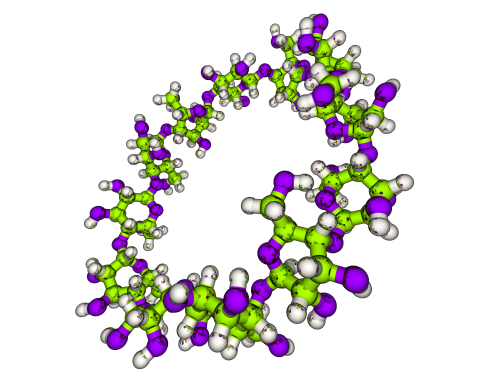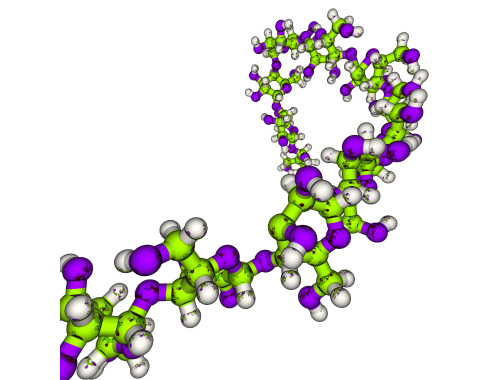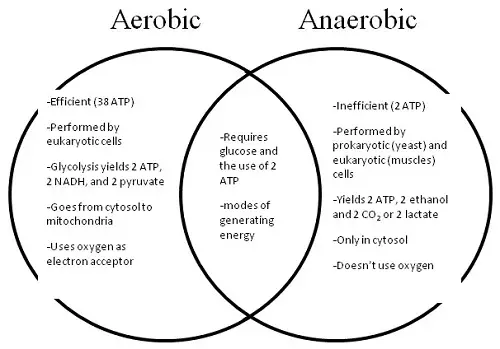
Starch, a complex carbohydrate, plays a vital role in our diet and serves as a major source of energy. It consists of two main components: amylose and amylopectin. These two compounds, although distinct, share certain similarities in their structures and functions.

Composition:
- Chemical Structure: Both amylose and amylopectin are polysaccharides composed of glucose units. They are essentially long chains of glucose molecules linked together by glycosidic bonds.
Glucose Units:
- Monomeric Units: The basic building block of both amylose and amylopectin is glucose. However, the way these glucose units are connected differs between the two.
Alpha-Glucose:
- Configuration: Amylose and amylopectin both consist of alpha-glucose molecules. The alpha configuration of glucose units enables them to form the characteristic helical structure seen in starch.
Function:
- Energy Storage: Both compounds serve as energy storage molecules in plants. Starch acts as a reserve of glucose, which can be broken down and used for energy when needed.
Insolubility:
- Water Insolubility: Amylose and amylopectin are both insoluble in water when in their natural state. However, they can be broken down into soluble components by enzymes during digestion.
Helical Structures:
- Coiled Forms: Amylose and amylopectin adopt helical structures. Amylose forms a tightly coiled helix due to the linear arrangement of glucose units, while amylopectin has a more branched and loosely coiled structure.
This table provides a concise overview of the similarities and differences between amylose and amylopectin, making it easier to grasp their key features at a glance.
| Feature | Amylose | Amylopectin |
|---|---|---|
| Chemical Structure | Linear chain of glucose molecules | Branched chain of glucose molecules |
| Composition | Polysaccharide | Polysaccharide |
| Monomeric Units | Glucose | Glucose |
| Configuration | Alpha-glucose | Alpha-glucose |
| Function | Energy storage in plants | Energy storage in plants |
| Insolubility | Insoluble in water (natural state) | Insoluble in water (natural state) |
| Helical Structure | Tightly coiled helix | Loosely coiled and branched structure |
| Role in Starch | Major component of starch | Major component of starch |
| Digestibility | Broken down into glucose during digestion | Broken down into glucose during digestion |
In conclusion, amylose and amylopectin, though distinct in their arrangements and functions, share fundamental similarities. Both are crucial components of starch, playing vital roles in energy storage in plants and contributing to the human diet. Understanding these similarities enhances our comprehension of the complexity of carbohydrates and their significance in nutrition.
Q1: What are amylose and amylopectin?
A1: Amylose and amylopectin are both components of starch, which is a complex carbohydrate found in plants. They are polysaccharides made up of glucose units.
Q2: How do the chemical structures of amylose and amylopectin differ?
A2: Amylose has a linear chain structure, while amylopectin has a branched chain structure. Amylose forms a tightly coiled helix, whereas amylopectin has a more loosely coiled and branched structure.
Q3: Are both amylose and amylopectin composed of glucose?
A3: Yes, both amylose and amylopectin are composed of glucose molecules. They are linked together by glycosidic bonds.
Q4: Do amylose and amylopectin serve the same function?
A4: Yes, both compounds serve as energy storage molecules in plants. Starch, consisting of amylose and amylopectin, acts as a reserve of glucose that can be utilized for energy.
Q5: Are amylose and amylopectin soluble in water?
A5: Both amylose and amylopectin are insoluble in water in their natural state. However, they can be broken down into soluble components by enzymes during digestion.
Q6: How do amylose and amylopectin contribute to starch?
A6: Amylose and amylopectin are the two major components of starch. Amylose forms a significant portion with its linear structure, while amylopectin contributes to the branched and more complex nature of starch.
Q7: Are there any references for further reading?
A7: Certainly, you can refer to biochemistry textbooks such as “Lehninger Principles of Biochemistry” by Nelson and Cox, or “Biochemistry” by Stryer for in-depth information.
Q8: Can you elaborate on the helical structures of amylose and amylopectin?
A8: Certainly! The helical structure in amylose is a result of the linear arrangement of glucose units, forming a tightly coiled helix. On the other hand, amylopectin’s helical structure is more loosely coiled due to its branched nature, with multiple points of glucose attachment.
Q9: How do enzymes interact with amylose and amylopectin during digestion?
A9: Enzymes such as amylase break down both amylose and amylopectin into smaller glucose units during digestion. Amylase cleaves the glycosidic bonds in the starch molecules, ultimately converting them into soluble sugars that can be absorbed and used for energy.
Q10: Are amylose and amylopectin found in other sources besides plants?
A10: While starch is primarily found in plants, similar polysaccharides with glucose units are found in different forms across various organisms. However, the specific structures and arrangements may vary.
Q11: Do amylose and amylopectin have any impact on dietary considerations?
A11: Yes, understanding the differences in amylose and amylopectin can be relevant in dietary planning. Foods with higher amylose content may have a lower glycemic index, affecting blood sugar levels differently than those with higher amylopectin content.
Q12: How do amylose and amylopectin contribute to the texture of starchy foods?
A12: The presence of amylose and amylopectin influences the texture of starchy foods. Higher amylose content tends to result in a firmer and more structured texture, while higher amylopectin content contributes to a softer and creamier texture.
Q13: Can you explain the role of amylose and amylopectin in plant metabolism?
A13: Certainly! In plants, amylose and amylopectin act as storage forms of glucose. During periods of photosynthesis when excess glucose is produced, it is converted into starch and stored as amylose and amylopectin. Later, when the plant needs energy, these compounds are broken down to provide a steady supply of glucose.
Q14: How do the similarities between amylose and amylopectin impact their joint function in starch?
A14: The similarities between amylose and amylopectin enhance the efficiency of starch as an energy storage molecule. Amylose’s linear structure allows for a more compact packing within the starch granule, while amylopectin’s branching provides multiple sites for enzyme action during digestion.
Q15: Can the differences in the structures of amylose and amylopectin be visually observed?
A15: Yes, under certain conditions, such as in microscopy or specialized imaging techniques, the distinct structures of amylose and amylopectin can be visualized. Amylose might appear as a more tightly wound structure, while amylopectin’s branching can give a more complex appearance.
Q16: How does the understanding of amylose and amylopectin benefit fields beyond biochemistry?
A16: Understanding these compounds is beneficial in fields like food science, as it influences the texture and properties of starchy foods. Additionally, it has implications in nutrition and health, helping to assess the impact of different starch compositions on dietary choices.
Q17: Are there any genetic factors influencing the ratio of amylose to amylopectin in plants?
A17: Yes, the ratio of amylose to amylopectin can be influenced by the plant’s genetics. Different plant varieties may have varying proportions, and genetic modification can be employed to tailor starch composition for specific purposes.
Q18: How do amylose and amylopectin contribute to the unique properties of starch in food preparation?
A18: Amylose and amylopectin play a crucial role in the gelatinization of starch during cooking. The swelling and eventual thickening of starch-containing foods, like sauces and gravies, are influenced by the interaction of these components with water and heat.
Q19: Can the differences in amylose and amylopectin content impact the nutritional value of starchy foods?
A19: Absolutely! Foods with higher amylose content may provide a more sustained release of glucose, impacting blood sugar levels differently than those with higher amylopectin content. This can be relevant in managing conditions like diabetes and in designing balanced diets.
Q20: How does the knowledge of amylose and amylopectin contribute to advancements in biotechnology?
A20: Understanding the structures and functions of amylose and amylopectin is valuable in biotechnological applications. It can aid in the development of genetically modified crops with tailored starch compositions for specific industrial or nutritional purposes.












Leave a Reply